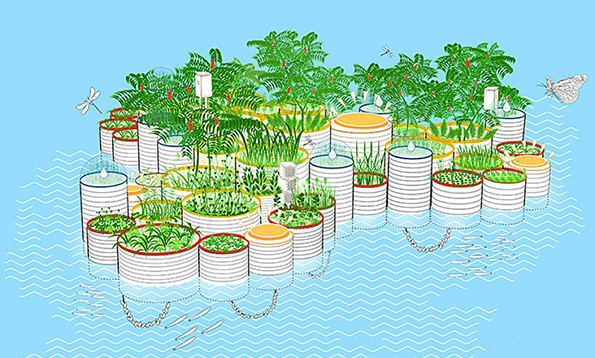Brooklyn’s famously polluted Gowanus Canal is now home to thriving floating gardens that are slowly giving the Superfund site new life.
Brooklyn’s famously polluted Gowanus Canal is now home to thriving floating gardens that are slowly giving the Superfund site new life.
The two-mile stretch of Brooklyn’s Gowanus Canal—home to a century’s worth of sewage, waste, and industrial pollution—is perhaps the last place you’d expect to see innovative green ideas take root. The canal made the Environmental Protection Agency’s list of Superfund sites in 2010, targeted for a long-term cleanup plan that is going to prove both difficult and expensive. As Sarah McColl at TakePart writes:
Just how gross is it? Fecal matter, usually measured in parts per million, is measured in parts per hundred in the Gowanus. When Whole Foods announced plans to open a store on 3rd Street near the canal in 2006, construction was delayed when leaky oil tanks were found buried beneath the 2.1-acre site, contaminating the soil with carcinogens.
But residents and volunteers aren’t waiting around for the EPA to finish dredging up and sealing off all the toxic sludge at the bottom of the canal—a project that isn’t due to be completed until 2022. In the meantime, the Gowanus Canal Conservancy is working to create greener spaces both within the canal and along its banks. Their most ambitious project yet is a floating garden housed in metal culvert pipes, which are supported by hundreds of recycled plastic bottles and 55-gallon plastic drums.
 The garden contains over 30 plant varieties, including sumac, smooth cordgrass, and seaside goldenrod. Some of the plants, such as swamp rose mallow, draw water directly from the canal and work to improve its quality through desalination and phytoremediation, a process by which plants detoxify water contaminated with heavy metals or excess minerals. Collected rainwater, and water distilled with solar-powered equipment (housed in small domes on the garden’s raft), help keep the rest of the plants hydrated and happy.
The garden contains over 30 plant varieties, including sumac, smooth cordgrass, and seaside goldenrod. Some of the plants, such as swamp rose mallow, draw water directly from the canal and work to improve its quality through desalination and phytoremediation, a process by which plants detoxify water contaminated with heavy metals or excess minerals. Collected rainwater, and water distilled with solar-powered equipment (housed in small domes on the garden’s raft), help keep the rest of the plants hydrated and happy.
That’s not all, though—the underside of these floating islands also introduces a unique substrate environment for mussels, which serve as tiny water filtration systems. (In a study performed at Stanford University in California, researchers placed mussels and clams into a tank with treated wastewater and discovered that within 72 hours, up to 80% of various contaminants had been removed.) The new floating habitat is also “catnip” for pollinators. “One hour after putting it in the canal, there were two butterflies playing around on it,” says Diana Balmori of Balmori Associates—the New York landscape and design firm that created the floating gardens. “It’s a beginning of a relationship with other living things.” There’s even a box installed for native solitary bees.
The New York Botanical Garden has suggested that herbs could be grown on the island in the future for use by local restaurants, once the canal has finished more of its Superfund cleanup and testing shows the water is free of toxic materials. For now, the gardens’ mission is already proving a success. By reintroducing native ecology to stagnant waters long burdened by pollution, the Gowanus is slowly being steered toward a brighter, more sustainable future.

What are some other creative initiatives you've seen to clean up contaminated water sources?
